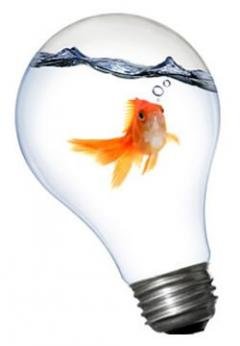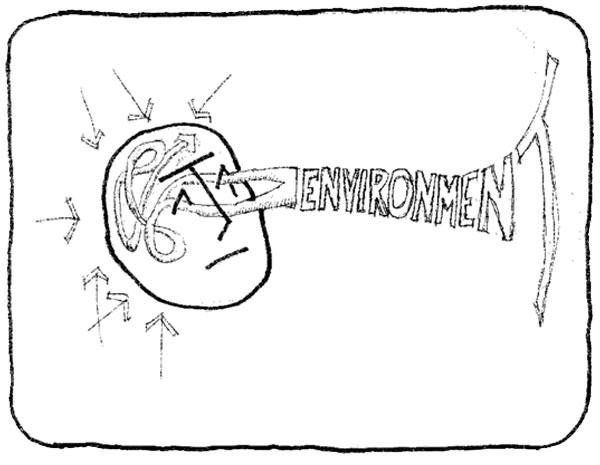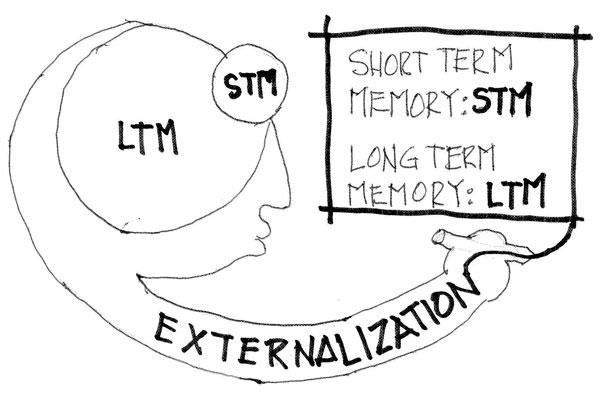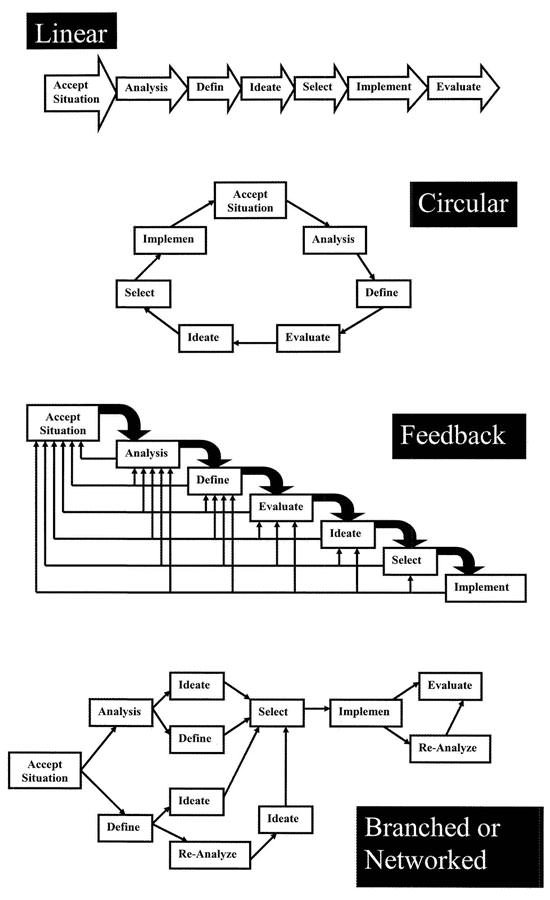
I was a student of architecture in the early 1970's, at a time when there was an emphasis on the art more than the science of the discipline. What I came to realize from that experience is this: there are many ideas. For every idea that seems to be the best solution to a given problem, there are an infinite number of other possibilities that will provide an even better solution.In other words, solutions were just a snapshot in time on the route to discovery. Perception, conception, expression: that's the basic path of the creative process. In those days, most of us would wait until the night before a project was due to prepare for it's presentation. That is because the perception phase was ongoing. We were continuing to gather information about the problem until the last minute.
What one discovers in the arts is that the creative process tends to be cyclical. Once we express a solution, feedback occurs and the process restarts. New ideas get born, spun off, shot down, ad infinitum.
The artist, whose art appears to evolve from a source that is deep in the soul, may consider it somewhat heretical to describe the creative act in analytical terms. But even the artist must utilize a great degree of discipline in the execution of his work. The musician must practice hour upon hour before he may improvise without inhibition. The painter must paint canvas after canvas before he can free himself to express with spontaneity. The freedom that results from these efforts has no bounds.

The scientist, on the other hand, embraces the purely analytical scientific method of problem solving. He is chained, in a way, to a linear form of thinking. Western culture has become trapped in this Cartesian world, and our economies and political systems manifest this one-sided way of thinking. One wonders where we would be today had Leonardo da Vinci's work been published immediately after his death.
I prefer the definitions of the word "create" that Webster uses. Webster, being the God-respecting patriot that he was, included a definition that implies divine origin (most dictionaries make no faith-based reference, but I'm not one to be as politically correct as these publishers are trying to be).
On Christmas day in 1991 I was in Kuwait, and my mother sent me a "book on the history of the Middle East," as she called it. I've discovered that there is a great deal of information in this book on the matter of creativity, and I've used it as one source for my concepts on this subject. There were a lot of creative doings in this area of the world during the dawn of civilization.
"There ain't no money in poetry.
That's what sets the poet free."– Guy Clark from Cold Dog Soup
One cannot forget to mention Arthur Koestler, who wrote the tome The Act of Creation. Koestler coined the term "bisociation," which deals with the focal point of creativity. When two concepts with seemingly unrelated properties are brought together in such a way to create a new concept, the process is said to be "bisociative." Koestler noted that there is a strong hedonistic response that results, and uses comic inspiration to illustrate the idea of bisociation. The accumulation of wealth is not the prime motivator for the artisan, and we have all heard of the stereotypical "starving artist."Another good book on the creative process was written by William Kirby Lockhard and is called Design Drawing. Lockhard's model for the design process can be effectively applied to the creative process. His topics include things like "MindModel," STM (short-term memory), LTM (long-term memory), and EM (external memory). LTM is akin to subconscious memory, while STM is akin to consciousness.

In the earliest edition of Design Drawing, Lockhard divides the design/creative process into five separate phases of mental activity: perception, conception, representation, decision, and persuasion. In later editions, I understand that he combined the last three concepts into one, but I haven't seen any of these editions. I still have the edition that I purchased in the early '70s. (My dog chewed it up a few years ago, but it's still readable. I have to keep it in an envelope as the binder no longer functions.)
A condensed version of Lockhard's design process is this:Perception is the research phase. Information obtained about the problem is gathered and stored in the LTM and STM.Conception involves comparing the known facets of the problem with all past experiences. It's a filtering process, kind of like what a computer does: items held in RAM (STM) are compared with items held in memory on the hard drive (LTM). The human filtering mechanism is highly specialized; as almost anything can be matched with the problem at hand.
This is where Koestler's concept of bisociation comes into play. Two concepts, having no relation to each other, are brought together in such a manner as to present a possible solution to the problem. Take for example the invention of the pocket calculator. Before about 1970, the two terms "pocket" and "calculator" would have never been used together. Texas Instruments changed this. Today, with the invention of PDAs, the pocket calculator seems to be a quaint idea.
The resulting ideas from the conception phase are then externalized in the representation phase. (I prefer to substitute the word "expression," as the word "representation" is more appropriate for designers, whereas "expression" applies to almost all artisans.) The process then restarts, as the ideas are expressed, discussed, modified, and more research (perception) is accomplished.

Another valuable reference on the subject of creative problem solving is The Universal Traveler: A Soft-Systems Guide to Creativity, Problem-Solving, and the Process of Reaching Goals, by Don Koberg and Jim Bagnall.I don't think that I can overstate the value of this book. In today's world, at a time when society looks to the paternal support of the state to meet the needs of the constituents, it is more important than ever that there be a rebirth of the individual. This thirty-plus-year-old publication is something that everyone can use to confront real-life problems and come up with real-life solutions. Anyone who feels that they don't have the creative problem-solving ability will find, in the pages of this book, that the real issue they have is fear. There are practical applications offered to help in overcoming this fear.

Universal Traveler (UT) suggests seven steps in the creative process: acceptance, analysis, definition, ideation, selection, implementation, and evaluation. These steps can occur as a process either linearly, cyclically, stepped with intermediate feedback loops, or as a branched network.

The model that I prefer to use is phased and has elements of Koestler, Lockhard, and Koberg/Bagnall combined. I consider perception, conception, and expression to be the primary phases of the creative process. In this model, I include some of UT's steps, as well as Design Drawing's steps, as interphased transitions within the ongoing creative thought process.

The creative process involves a free flow of information such that ideas are thrown off almost randomly and with some degree of reckless abandon. Some are kept, some are tabled, some are discarded, and some are combined with others. The process can be structured or improvised, planned or spontaneous, consciously executed or subconsciously derived. The number of ideas that are generated tends to be a function of the amount of information gathered during the perception phase(s).
The discovery phase of the creative process begins at birth. We learn and the environment that is specific to our life influences how we perceive the world. Physicists use the term "bulk" to describe a hypothetical macro multidimensional universe that is interconnected in ways that we are only beginning to understand. The collective consciousness of the human experience can be modeled in a similar way. The "bulk" of human knowledge is similarly connected, and as such, is owned collectively. (I use this term "collectively" at the risk that some will interpret it to be a socialistic notion. It might be more correct to say that the bulk of human knowledge is "public domain.") Our individual life experiences draw on the human experiential "bulk," as well as the "EM displays" that are provided by the common domain of nature.
Fritjof Capra, in his recent book on the codices of Leonardo da Vince, poses the question that I touched on earlier: what sort of world would we live in today had the work of Leonardo been published immediately after his death. Because Leonardo relied as much on art as he did the scientific method, western science would have evolved quite differently. Our politics would be different. Our economic system would be different. We would not be locked in this Cartesian mindset that permeates though the education system. The butterfly effectwould only amplify the differences between that world and the world that we currently live in.
Through "perceptive assimilation," the creative ideas that emerge from our experiential "bulk" are not necessarily the sum of their components. Nor can they be evaluated in terms of the differences between their components. There is cooperation between (1) the creator who accepts the problem at hand and forces theemergence of the solution, and (2) the collectively owned human experiential "bulk."This suggests, at the very least, that there is a partnership between the artist and the public domain — the owner of the "bulk." If this is the case, then the ownership of intellectual property cannot be assigned wholly to the individual. And because of the relative difference in value between the artist's contribution and the "bulk" that is drawn on to deliver the contribution, one could further infer that the artist's ownership position is a minor one. The relative value to society may or may not increase over time, depending on the contribution.
Further, there is a new field called biocentrics that suggests sentient beings exist for perceptive assimilation of their environment. Reality is probabilistic without observation. The phantom probabilistic cloud particles speculated by particle physicists remain undefined without sentient beings to observe their entangled matrix. Perspective assimilation becomes the key to unlocking the EM database.
All of this gives a whole new meaning to the book of Genesis. "In His image" becomes quite a profound phrase, as we are literally and intimately entangled in the great opera of being.I started this article with only a loose understanding of where I was going with it. As with many projects, I got interrupted with life, one item being a professional accreditation exam. But during this time I was lucky enough to stumble upon a few things that enabled me to expand on my original thesis of perception, conception, and expression.
One item came from an unlikely source: a Tea Party rally in Clear Lake, Texas where I went to hear the rock star of liberty speak: Dr. Ron Paul. One of the speakers who took the podium before Dr. Paul was a Cuban immigrant who currently resides in Oregon. His name escapes me and I would really like to give him credit for this notion. His talk was on our (relatively) free-market system, and how lucky we are to have it, how we take for granted the abundance and the diversity of selections that are available to us when we go to a grocery store or any other market. What he ended with — the idea that whacked me right on the side of the head — was this: the notion that without liberty, there is no creativity. Without freedom, there is no reason to endure the pain of discipline that is required for creative problem solving.
Freedom, or liberty, is the natural law that the Founders knew put us in the image of God. This is the lesson that I have learned.
Hi! I am a content-detection robot. This post is to help manual curators; I have NOT flagged you.
Here is similar content:
https://mises.org/library/how-creative-process-works
Yes, I authored that as well.
!cheetah whitelist
Okay, I have whitelisted @cactusclef. I won't bug them.
Do you have a mechanism for verifying your account? I just sent you an email to ensure this is not a case of identity theft.
I replied. I hope this suffices. Regards.
Confirmed! Thank you.
This is the best piece of prose based strictly on style that I've ever read on steemit so have an upvote. Also its an interesting article on creativity. Thinking of the process as coming up with varius solutions and then vetting them is clearly what happens but I hadn't thought of it that way before. Keep it up!
Thanks so much for your kind review.